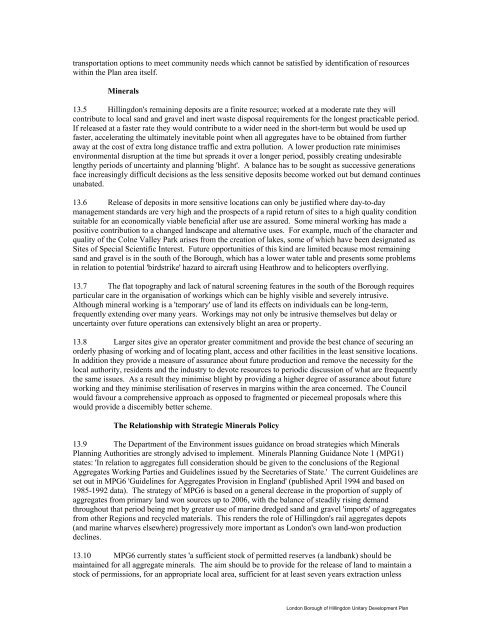HILLINGDON UNITARY DEVELOPMENT PLAN - London Borough ...
HILLINGDON UNITARY DEVELOPMENT PLAN - London Borough ...
HILLINGDON UNITARY DEVELOPMENT PLAN - London Borough ...
Create successful ePaper yourself
Turn your PDF publications into a flip-book with our unique Google optimized e-Paper software.
transportation options to meet community needs which cannot be satisfied by identification of resources<br />
within the Plan area itself.<br />
Minerals<br />
13.5 Hillingdon's remaining deposits are a finite resource; worked at a moderate rate they will<br />
contribute to local sand and gravel and inert waste disposal requirements for the longest practicable period.<br />
If released at a faster rate they would contribute to a wider need in the short-term but would be used up<br />
faster, accelerating the ultimately inevitable point when all aggregates have to be obtained from further<br />
away at the cost of extra long distance traffic and extra pollution. A lower production rate minimises<br />
environmental disruption at the time but spreads it over a longer period, possibly creating undesirable<br />
lengthy periods of uncertainty and planning 'blight'. A balance has to be sought as successive generations<br />
face increasingly difficult decisions as the less sensitive deposits become worked out but demand continues<br />
unabated.<br />
13.6 Release of deposits in more sensitive locations can only be justified where day-to-day<br />
management standards are very high and the prospects of a rapid return of sites to a high quality condition<br />
suitable for an economically viable beneficial after use are assured. Some mineral working has made a<br />
positive contribution to a changed landscape and alternative uses. For example, much of the character and<br />
quality of the Colne Valley Park arises from the creation of lakes, some of which have been designated as<br />
Sites of Special Scientific Interest. Future opportunities of this kind are limited because most remaining<br />
sand and gravel is in the south of the <strong>Borough</strong>, which has a lower water table and presents some problems<br />
in relation to potential 'birdstrike' hazard to aircraft using Heathrow and to helicopters overflying.<br />
13.7 The flat topography and lack of natural screening features in the south of the <strong>Borough</strong> requires<br />
particular care in the organisation of workings which can be highly visible and severely intrusive.<br />
Although mineral working is a 'temporary' use of land its effects on individuals can be long-term,<br />
frequently extending over many years. Workings may not only be intrusive themselves but delay or<br />
uncertainty over future operations can extensively blight an area or property.<br />
13.8 Larger sites give an operator greater commitment and provide the best chance of securing an<br />
orderly phasing of working and of locating plant, access and other facilities in the least sensitive locations.<br />
In addition they provide a measure of assurance about future production and remove the necessity for the<br />
local authority, residents and the industry to devote resources to periodic discussion of what are frequently<br />
the same issues. As a result they minimise blight by providing a higher degree of assurance about future<br />
working and they minimise sterilisation of reserves in margins within the area concerned. The Council<br />
would favour a comprehensive approach as opposed to fragmented or piecemeal proposals where this<br />
would provide a discernibly better scheme.<br />
The Relationship with Strategic Minerals Policy<br />
13.9 The Department of the Environment issues guidance on broad strategies which Minerals<br />
Planning Authorities are strongly advised to implement. Minerals Planning Guidance Note 1 (MPG1)<br />
states: 'In relation to aggregates full consideration should be given to the conclusions of the Regional<br />
Aggregates Working Parties and Guidelines issued by the Secretaries of State.' The current Guidelines are<br />
set out in MPG6 'Guidelines for Aggregates Provision in England' (published April 1994 and based on<br />
1985-1992 data). The strategy of MPG6 is based on a general decrease in the proportion of supply of<br />
aggregates from primary land won sources up to 2006, with the balance of steadily rising demand<br />
throughout that period being met by greater use of marine dredged sand and gravel 'imports' of aggregates<br />
from other Regions and recycled materials. This renders the role of Hillingdon's rail aggregates depots<br />
(and marine wharves elsewhere) progressively more important as <strong>London</strong>'s own land-won production<br />
declines.<br />
13.10 MPG6 currently states 'a sufficient stock of permitted reserves (a landbank) should be<br />
maintained for all aggregate minerals. The aim should be to provide for the release of land to maintain a<br />
stock of permissions, for an appropriate local area, sufficient for at least seven years extraction unless<br />
<strong>London</strong> <strong>Borough</strong> of Hillingdon Unitary Development Plan
















